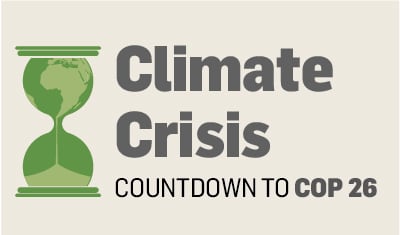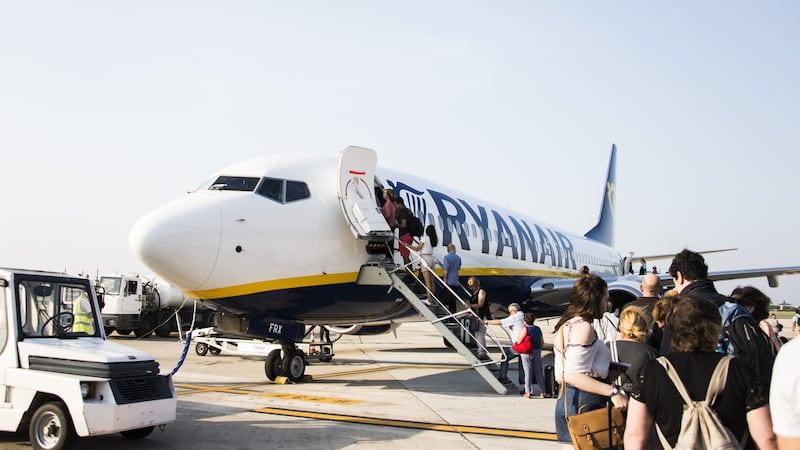It is only a matter of time before Ireland’s conflicting priorities on climate change and aviation come in to land, most likely with a thud. The looming conflict is, for now, mostly unacknowledged by the industry and Government. But a clash is unavoidable and there is no Irish plan to manage a problem that could slap the aviation sector in the face like a wet fish.

About 20,000 politicians, scientists and policymakers will in coming days descend on Glasgow for the Cop26 United Nations Climate Change Conference. They won't swim to Scotland; most will fly there because air travel is essential to how modern society functions. After they land, one of their main tasks will be to devise a deal to bring aviation emissions to net zero by 2050.
The British are pushing hard for an aviation agreement at Cop26. As temperatures rise in future and countries run out of ways to cut emissions, the debate about flying is only going to get hotter and hotter.
Aviation emissions account for only 2-3 per cent of the world’s total but the issue isn’t going to slip down the agenda. Logic suggests that, as other emission sources fall, aviation’s share will rise and it can only climb up the list of priorities. This realisation should hold true no matter which side of the debate you are.
With the possible exception of Iceland or Malta, no other country in Europe is as exposed to this issue as Ireland. Dublin is a global centre of aviation financing, while one of Ireland's most successful indigenous multinationals of the last two decades, Ryanair, is a clear leader of Europe's aviation sector.
Meanwhile, the Irish economy is probably the most globally enmeshed in the western world and access to air connectivity is its lifeblood. We’re surrounded by water, so nine in 10 visitors here arrive on planes.
Aircraft emissions
You would expect Ireland, of all countries, to be at the forefront of efforts to cut the Gordian knot of limiting aviation emissions without throttling economies or making air travel so expensive that only the rich can fly. Yet in the State’s carbon budgets announced this week to cut emissions by 51 per cent over the next decade, aviation (along with shipping) was left out of the calculations altogether because, clearly, nobody knows what to do.
It may be a quandary for an island nation but the Government, the industry and wider society will have to face up to it. A neat Irish solution isn’t going to fall out of the sky all by itself.
Other countries with different attitudes towards aviation are going to come up with a supranational template that Ireland, eventually, will have to adopt. The Government may as well jump in and get its hands dirty in this process, where at least it can have some influence.
There are rumblings internationally to suggest the issue is shifting closer to centre stage. About 290 airline members of the International Air Transport Association, led by former Aer Lingus chief executive Willie Walsh, this month agreed to target net-zero emissions by 2050. This is in line with the objectives of the Paris climate accord but it is also nearly three decades away. How are they going to get there in the meantime?
If the British push at Glasgow is successful, a new International Aviation Climate Ambition Coalition will launch a drive for binding industry targets. This may put irresistible pressure on the UN body that oversees global aviation, the International Civil Aviation Organisation (ICOA), to put the aspirations into hard and fast rules.

Flight taxes
Governments everywhere are afraid to tell people they plan to stop them flying as often as they do currently through the imposition of fresh taxes, or even restrictions on capacity. This is especially true in Ireland. Eamon Ryan, the Green Party leader and Minister for Transport (and also Minister for Climate Action), said in August that the Government could not simply tell people "thou shalt not fly". "It won't work," he said. And he may be correct on that.
Ryan is pinning his hopes on technological advances such as sustainable aviation fuel to dilute or eventually even replace carbon-belching kerosene. But how likely is that to arrive in time for the aviation sector to meet the binding emissions targets that loom?
Scientists are working hard to devise new ways of manufacturing sustainable aviation fuel from biomass, The British government recently launched an industry consultation on the issue. The document reveals, however, that the current best efforts at sustainable aviation fuel, such as a method of converting sugar into jet fuel, are up to eight times as expensive to produce as kerosene. It warned of a “valley death” between development in laboratories and commercialisation.
Scientists are also exploring how to turn human solid waste and cooking oil into additives for aviation fuel. Airplanes will likely have to compete with transport modes on the ground for the latter resource – there are only so many fryers producing cooking oil. Boosting stocks might address climate change, but we’ll all end up with diabetes.
Jet fuel
An affordable, plentiful supply line of sustainable aviation fuel to dilute or replace kerosene in jet fuel is years away, perhaps even decades. The only way it will ever be widely adopted is if governments subsidise it heavily and then make it mandatory. This will have huge knock-on implications for aircraft engine manufacturers, airlines and eventually customers. It is difficult to know how that will play out.
Unless science comes to the rescue with a technological lightbulb moment, governments and international regulators may in coming years be tempted to turn to hard restrictions on aviation capacity.
Greenpeace this week called for a European Union ban on flights within the continent where a train journey of six hours or less is available as an alternative. It sounds utterly bonkers now. But as climate panic increases in coming years, such restrictions, unfortunately, could be viewed differently.
In the meantime, many airlines are ploughing ahead with expansion plans. Ryanair is expecting delivery of another 210 Boeing 737-Max planes and recently upped its growth target by 25 million passengers annually to 225 million per year by 2026.
It was flying 149 million passengers per year before the pandemic – the airline plans to be 50 per cent bigger than it ever was five years from now. On its track record, who says it won’t get there?
Yet it is also hard to see how the industry and climate change policymakers can resolve their conflicting priorities without significant change ahead. They seem like vehicles attached to the same length rope, but pulling in opposite directions. Eventually it has to snap. What then?










